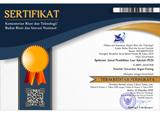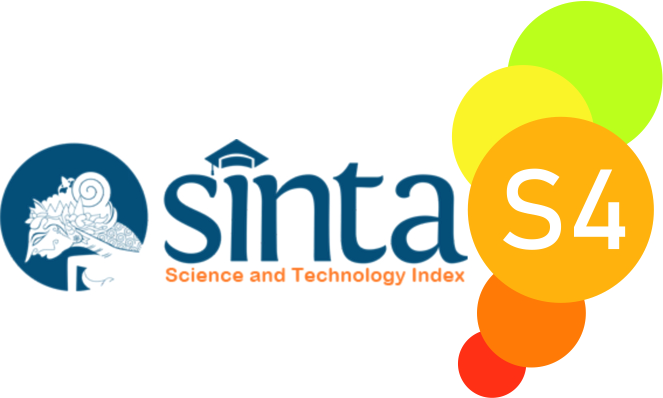SPATIAL VISUAL INTELLIGENCE AND LEARNING INDEPENDENCE IN INFORMAL LEARNING RESULTS AT HOME DURING THE PANDEMI COVID-19
 ),
), (1) SMK Negeri 6 Malang
 Corresponding Author
Corresponding Author
DOI : https://doi.org/10.24036/spektrumpls.v8i3.110012
Full Text:
 Language : en
Language : en
Abstract
Spatial visual intelligence has a significant influence on the online learning process because of the independence of students in the informal learning process. Furthermore, this study aims to determine the relationship of spatial visual intelligence and learning independence to student learning outcomes in online learning activities during the COVID-19 pandemic, especially in the DPTM (Basic Mechanical Engineering Design) subject in class X TPM SMK Negeri 6 Malang in the 2020 academic year. / 2021. The design of this study is a correlation with a quantitative approach. The subjects of this study were 82 students of class X Mechanical Engineering at SMK Negeri 6 Malang. Data collection techniques are tests, questionnaires, and documentation. The data analysis used linear and multiple regression statistics. The results showed that visual spatial intelligence and students' learning independence were high in the basic subjects of Mechanical Engineering Planning. Each variable has a relationship and influence on student learning outcomes. This is indicated by the value of student learning outcomes with high criteria. So, it can be concluded that each variable simultaneously has a positive effect on learning outcomes.
References
Abdullah, A. H., Mokhtar, M., Wahab, R. A., & Atan, N. A. (2018). A Learning 3D Geometry through Sketchup Make (SPPD-SUM) to Enhance Visual Spatial Skills and the Level of Geometric Thinking. Journal of Fundamental and Applied Sciences, 10(6S), 1105–1039. https://doi.org/10.4314/jfas.v10i6s.50
Akareem, H. S., & Hossain, S. S. (2016). Determinants of Education Quality: What Makes Students’ PerceptionDifferent? Open Review of Educational Research, 3(1), 52–67. https://doi.org/10.1080/23265507.2016.1155167
Armbruster, P., Patel, M., Johnson, E., & Weiss, M. (2013). Active Learning and Student-centered Pedagogy Improve Student Attitudes and Performance in Introductory Biology. CBE-Life Sciences Education, 8, 203–213. https://doi.org/10.1187/cbe.09
Cocodia, E. A. (2014). Cultural Perceptions of Human Intelligence. Journal of Intelligence, 2(4), 180–196. https://doi.org/10.3390/jintelligence2040180
Direktorat Pembinaan SMK. 2018. Bantuan Modal Pengembangan Kelas Wirausaha. www.psmk. kemdikbud.go.id diakses 25 Maret 2018.
Effendi, M. (1970). Peranan Internet sebagai Media Komunikasi. KOMUNIKA: Jurnal Dakwah Dan Komunikasi, 4(1), 130–142. https://doi.org/10.24090/komunika.v3i2.143
Fahmy, A. F. R., Wardono, W., & Masrukan, M. (2018). Kemampuan Literasi Matematika dan Kemandirian Belajar Siswa pada Model Pembelajaran Rme Berbantuan Geogebra. Prisma, Prosiding Seminar Nasional Matematika, 1, 559–567. Retrieved from https://journal.unnes.ac.id/sju/index.php/prisma/article/view/20198/9576
Gani, A., Safitri, R., & Mahyana, M. (2017). Improving the Visual-Spatial Intelligence and Results of Learning of Juniour High School Students’ with Multiple Intelligences-Based Students Worksheet Learning on Lens Materials. Jurnal Pendidikan IPA Indonesia, 6(1), 16–22. https://doi.org/10.15294/jpii.v6i1.9594
Gardner, H. (1983). Multiple Intelligence: The Theory in Practice. New York: Basic Books.
Iwamoto, D. H., Hargis, J., Bordner, R., & Chandler, inani. (2017). International Journal for the Scholarship of Teaching and Learning Self-Regulated Learning as a Critical Attribute for Successful Teaching and Learning Self-Regulated Learning as a Critical Attribute for Successful Teaching and Learning. International Journal for the Scholarship of Teaching and Learning, 11(2). Retrieved from https://doi.org/10.20429/ijsotl.2017.110207
Kurniawati, M., Junaedi, I., & Mariani, S. (2015). Analisis Karakteristik Berpikir Geometri Dan Kemandirian Belajar Dalam Pembelajaran Fase Van Hiele Berbantuan Geometers Sketchpad. Unnes Journal of Research Mathematics Education, 4(2), 102–107. Retrieved from https://journal.unnes.ac.id/sju/index.php/ujmer/article/view/9836
Novitasari, D., Rahman, A., & Alimuddin, A. (2015). Profil Kreativitas Siswa dalam Pemecahan Masalah Matematika ditinjau dari Kecerdasan Visual Spasial dan Logis Matematis pada Siswa SMAN 3 Makasar. Jurnal Daya Matematis, 3(1), 41–50. https://doi.org/10.26858/jds.v3i1.1315
Pangestu, S. M. (2017). Pengaruh Tingkat Kedisiplinan Belajar dan Kemandirian Belajar Terhadap Hasil Belajar Mata Pelajaran Ekonomi Siswa Kelas XI IIS SMA Negeri 1 Kepanjen. Universitas Negeri Malang. Retrieved from http://repository.um.ac.id/39810/
Permendiknas No. 23 Tahun 2006 tentang Standar Kompetensi Lulusan untuk Satuan Pendidikan Dasar dan Menengah.
Rimbatmojo, S., Kusmayadi, T. A., & Riyadi, R. (2017). Metacognition Difficulty of Students with Visual-Spatial Intelligence during Solving Open-Ended Problem. Journal of Physics: Conference Series, 895(1). https://doi.org/10.1088/1742-6596/895/1/012034
Sumarno, U. (2004). Kemandirian Belajar: Apa, Mengapa, dan Bagaimana dikembangkan pada Peserta Didik. Bandung: FPMIPA UPI.
Tirtarahardja, U., & Sulo, L. (2008). Pengantar Pendidikan. Jakarta: Rineka Cipta.
Turgut, M., & Uygan, C. (2015). Designing Spatial Visualisation Tasks for Middle School Students with a 3D Modelling Software: An Instrumental Approach. International Journal for Technology in Mathematics Education, 22(2), 45–52. https://doi.org/10.1564/tme_v22.2.01
Wahyudi, M. A., Widiyanti, W., & Nurhadi, D. (2018). Kecerdasan Visual Spasial dan Kemandirian Belajar pada Hasil Belajar Mata Pelajaran Gambar Teknik di SMK. Teknologi Dan Kejuruan: Jurnal Teknologi, Kejuruan, Dan Pengajarannya, 41(2), 101–109. https://doi.org/10.17977/um031v42i22018p101
Yenilmez, K., & Kakmaci, O. (2015). Investigation of the relationship between the Spatial Visualization Success and Visual/Spatial Intelligence Capabilities of Sixth Grade Students. International Journal of Instruction, 8(1), 189–204. https://doi.org/10.12973/iji.2015.8114a
 Article Metrics
Article Metrics
 Abstract Views : 584 times
Abstract Views : 584 times
 PDF Downloaded : 139 times
PDF Downloaded : 139 times
Refbacks
- There are currently no refbacks.

This work is licensed under a Creative Commons Attribution-NonCommercial 4.0 International License.



